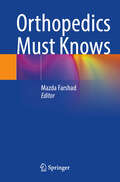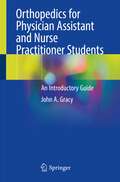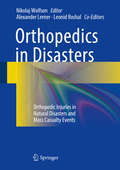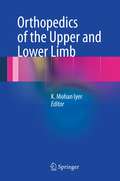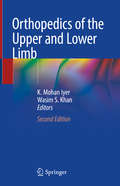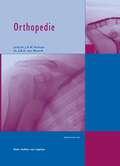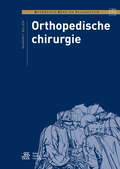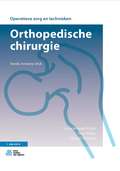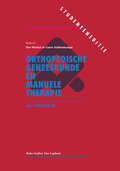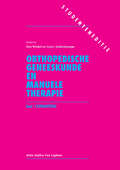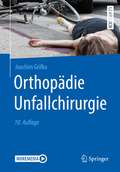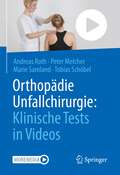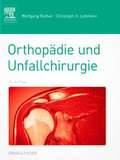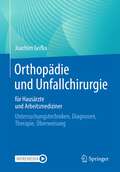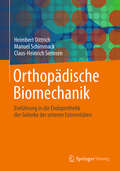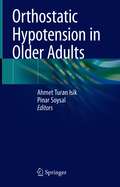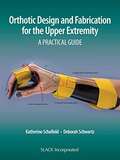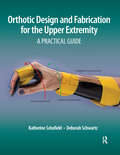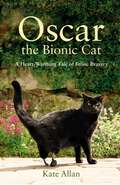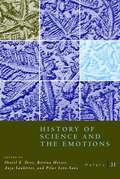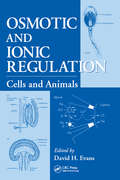- Table View
- List View
Orthopedics Must Knows
by Mazda FarshadThis concise textbook provides health care professionals with all the essential knowledge (i.e. must knows) in the field of orthopedics, including dedicated sections for the orthopedic board exam. Following a schematic and homogeneous format it guides the reader through all musculoskeletal structures and diseases, including their diagnoses and management. Subdivided into 15 chapters, it covers the main joints, related surgical and technical procedures, pediatric orthopedics, as well as orthopedic tumors and infections. A dedicated chapter is moreover devoted to essential statistical methods. The basis of the English translation of this book, originally in German, was facilitated by artificial intelligence. The content was later updated, enhanced and revised by the authors for accuracy. This handy and easy-to-read textbook offers a clear and concise compendium of orthopedic knowledge invaluable for everyone approaching the orthopedic field.
Orthopedics for Physician Assistant and Nurse Practitioner Students: An Introductory Guide
by John A. GracyThis practical introductory guide provides PA/NP students with the tools to recognize and begin treatment of the most common orthopedic problems, to avoid missing critical diagnoses, and to serve as a base of knowledge to which they can add depending on their chosen career path. Utilizing this concise text, PA/NP students will gain a basic familiarity with how to describe a problem (including imaging) to an orthopedic surgeon as well as how to begin treatment. In addition, the student should have no difficulty passing the orthopedic portion of the PA/NP credentialing exams. The essentials of imaging, fracture description and operating room procedures are presented first. Then, proceeding anatomically from upper to lower extremity and the spine, chapters utilize a user-friendly chapter format covering fractures, dislocations and trauma as well as non-traumatic injury, focusing on pathophysiology, diagnosis and differential diagnosis, and brief treatment protocols. Since many PAs are office-based, only the highlights of surgery are presented, with an emphasis on what to look for regarding post-operative complications as well as the goals of the rehabilitation process (both non-operative and post-operative).Many books intended for orthopedic PA/NP students are written for those already in practice, usually providing far more information than the student can absorb in the usual 4-week orthopedic rotation, while others tend to skip important areas. This guide provides concise yet comprehensive coverage for a well-rounded presentation of everything orthopedic PA/NP students need to know to succeed.
Orthopedics in Disasters
by Nikolaj Wolfson Alexander Lerner Leonid RoshalThis book is the first to address specifically the mechanisms and treatment of orthopedic injuries due to natural disasters and other mass casualty events. Casualty management is discussed in a range of contexts, from earthquakes and tsunamis to terror attacks and combat situations. Organizational aspects are addressed, general treatment principles are documented, and the management of a variety of orthopedic injuries is described with the aid of numerous illustrations. The book will serve as an invaluable source of practical knowledge for a broad spectrum of medical and other staff, including emergency personnel, orthopedic and trauma surgeons, general practitioners, medical students, and professionals working for the military, government bodies, and NGOs.
Orthopedics of the Upper and Lower Limb
by K. Mohan IyerThis book has been written by established Orthopedic Surgeons who have become dedicated specialists within their particular subspecialty. They have contributed by writing highly detailed chapters that educate the reader with the basic science, accepted fundamentals and most recent trends within the full range of orthopedic management of upper and lower limb orthopedic disorders.It is intended that this well illustrated and highly informative text book to provide orthopedic surgeons in training with comprehensive and relevant core knowledge on all aspects of orthopedics of the upper and lower limb, and will become an essential guide for surgeons in training, providing step by step approaches to performing initial diagnosis, surgical procedures and post operative management.
Orthopedics of the Upper and Lower Limb
by K. Mohan Iyer Wasim S. KhanThe second edition of this book provides a practical guide to the latest diagnostic and therapeutic techniques in orthopedics for both the upper and lower limb. Extensively revised chapters provide detailed step-by-step instructions on how to perform basic clinical and surface, anatomy examinations on joints including the hand, elbow and ankle. The application of relevant surgical procedures and post-operative management techniques are also detailed. New topics covered include cruciate ligament injuries, and robot assisted surgery.Orthopedics of the Upper and Lower Limb is an ideal resource for trainees and junior surgeons seeking an easy to follow clinical manual on how to successfully diagnose and treat patients with orthopedic disorders affecting both limbs. It is also of use to the experienced practitioner seeking a detailed resource on the latest advances in the field.
Orthopedie (Quintessens)
by J. A. N. Verhaar and J. B. A. MourikDe afgelopen jaren heeft het leerboek Orthopedie in Nederland een centrale plaats verworven in het medische en paramedische onderwijs. Orthopedie is hiermee uitgegroeid tot het meest gebruikte leerboek van aandoeningen van het bewegingsapparaat, te weten botten, spieren, pezen en gewrichten.Orthopedie is tekstueel volledig herzien op basis van de laatste ontwikkelingen en wetenschappelijke inzichten. Daarnaast is het boek uitgebreid met nieuw beeldmateriaal. Nieuw zijn ook de intermezzo's en kernpunten in de afzonderlijke hoofdstukken. Deze elementen bieden de lezer een handvat bij het lezen van de tekst en vergemakkelijken zo het studeren.De opbouw in vier secties is gehandhaafd: A. Een algemeen deel om een overzicht te krijgen van het onderzoek en de behandelingsprincipes in de orthopedie.B. Een ruim deel over orthopedische traumatologie.C. Een deel over kinderorthopedische problemen.D. Een overzicht van de orthopedische aandoeningen bij volwassenen.Vele auteurs, experts in hun deelgebied, leveren een bijdrage, in zowel tekst als beeld. Het leerboek bevat een groot aantal illustraties en tekeningen in twee kleuren, die een goed beeld van de verschillende aandoeningen geven.Het boek bevat essentiële informatie voor studenten in medische vakken en legt de nadruk op de meest voorkomende aandoeningen. Behalve voor studenten geneeskunde en arts-assistenten is Orthopedie geschikt voor fysiotherapeuten en verpleegkundigen met een specialisatie in de orthopedie.
Orthopedische chirurgie
by Margret BeliënDe reeks `Operatieve Zorg & Technieken is bestemd voor de opleiding tot operatieassistent. Naast het basisboek bestaat de reeks uit aantal vervolgdelen waarin de verschillende sub specialismen van de chirurgie worden behandeld. Elk deel in de reeks heeft dezelfde indeling; achterin wordt altijd een selectie opgenomen van veelvoorkomend specifiek instrumentarium. Ieder hoofdstuk begint met een inleiding, gevolgd door een uitwerking van de pre-, per- en postoperatieve fase van de operatie. Bij alle operatiebeschrijvingen staat een vermelding van de operatie-indicatie en het doel van de operatie. De opstelling van het operatieteam wordt per operatiebeschrijving verduidelijkt door een afbeelding. De reeks `Operatieve Zorg & Technieken benadert de beroepsuitoefening van de operatieassistent zo dicht mogelijk. De talrijke afbeeldingen onderbouwen deze benadering. Orthopedische chirurgie behandelt een van de thans belangrijkste snijdende specialismen. In dit boek worden de meest voorkomende basistechnieken en behandelingsmethoden beschreven. Om de leesbaarheid niet in gevaar te brengen is ervoor gekozen de algemene basisoperatietechnieken, die ook in dit boek van toepassing zijn, niet opnieuw te bespreken. Deze worden reeds weergegeven in de andere delen (met name in Traumatologie van extremiteiten en bekken). Orthopedische chirurgie is dan ook niet los te zien van de hele reeks.
Orthopedische chirurgie (Operatieve zorg en technieken)
by Sonja de Jong-Perdijk Arne Wibier Faiiza El-AmraouiDit leerboek helpt operatieassistenten de juiste operatieve voorbereidingsroute te bewandelen voor orthopedische operaties. Dat doet het met orthopedische achtergrondinformatie, én met inzicht in het pre-, per- en postoperatieve proces. Het focust daarbij op operaties van de bovenste tot de onderste extremiteit. Het boek richt zich in de eerste plaats op operatieassistenten in opleiding, operatieassistenten die zich moeten bekwamen in een nieuwe ingreep, en roulerende operatieassistenten. Maar het is ook zeer geschikt als naslagwerk voor andere beroepen in de gezondheidszorg.Orthopedische chirurgie is onderdeel van de reeks operatieve zorg en technieken (OZT), die bestaat uit het basisboek en vervolgdelen die elk gekoppeld zijn aan een specialisme. Dit deel beschrijft de operaties aan extremiteiten, van de bovenste tot de onderste. In deze herziene versie zijn een aantal operaties achterwege gelaten die niet meer worden uitgevoerd, of die in andere delen van de reeks al worden beschreven. Ook is een aantal nieuwe operaties toegevoegd, en zijn bestaande operaties tegen het licht gehouden van de hedendaagse technieken. Waar nodig zijn ze aangepast, bijvoorbeeld met andere afbeeldingen.Sonja de Jong-Perdijk is operatieassistent in Amsterdam UMC. Arne Wibier is operatieassistent en vakspecialist orthopedie in het Albert Schweitzer ziekenhuis. Faiiza El-Amraoui is operatieassistent en werkt gedetacheerd met expertise orthopedie.
Orthopedische geneeskunde en manuele therapie
by F. D. WinkelEen selectie van hoofdstukken uit de uitgebreide serie 'Orthopedische Geneeskunde en Manuele Therapie'. Doordat de selectie geheel is toegesneden op de opleidingen is de voor de student overbodige wetenschappelijke stof hier weggelaten. Dat neemt niet weg dat alle belangrijke manueel therapeutische onderzoek- en behandeltechnieken educatief worden beschreven aan de hand van uitgebreid illustratiemateriaal.
Orthopedische geneeskunde en manuele therapie
by F. D. WinkelEen selectie van hoofdstukken uit de uitgebreide serie 'Orthopedische Geneeskunde en Manuele Therapie'. Doordat de selectie geheel is toegesneden op de opleidingen is de voor de student overbodige wetenschappelijke stof hier weggelaten. Dat neemt niet weg dat alle belangrijke manueel therapeutische onderzoek- en behandeltechnieken educatief worden beschreven aan de hand van uitgebreid illustratiemateriaal.
Orthopäden und Wirbelsäulenchirurgen im kritischen Gespräch: 61 freimütige Interviews
by Rainer-Peter Meyer Andreas Lütscher Bruno Brantschen Dezsö J. Jeszenszky30 spontane Fragen an 61 Orthopäden und Wirbelsäulenchirurgen zu richten, bedarf einer gewissen Unverfrorenheit. Alle diese Persönlichkeiten haben die Herausforderung angenommen. Nichts wurde beschönigt, keiner der Autoren hat sich «versteckt». Lassen Sie sich vom Resultat überraschen.
Orthopädie Unfallchirurgie
by Joachim GrifkaDer Lehrbuchklassiker von Grifka und Krämer bringt kurz und prägnant die Orthopädie und Unfallchirurgie auf den Punkt. Untersuchungstechniken, orthopädische und unfallchirurgische Krankheitsbilder nach Körperregionen, konservative und operative Therapien, Rehabilitation, Begutachtung und Definitionen aller Krankheitsbilder stellen die Autoren übersichtlich dar. Ein Lernquiz mit 20 typischen Alltagssituationen bietet einen ersten Einstieg in die Praxis. Das Buch ist zur schnellen Vorbereitung auf die Prüfung bestens geeignet.
Orthopädie Unfallchirurgie: Klinische Tests in Videos
by Andreas Roth Peter Melcher Marie Samland Tobias SchöbelIm vorliegenden Buch sind die wichtigsten orthopädisch-traumatologischen Untersuchungstechniken systematisiert dargestellt. In einem ersten Schritt werden die Untersuchungstechniken sowie die pathophysiologischen Hintergründe aufgeführt. Es erfolgt eine Schritt-für-Schritt-Beschreibung der Durchführung aller relevanten Untersuchungen. Diese schriftliche Darstellung kann als schnelles Nachschlagewerk in der Kitteltasche oder zum theoretischen Erlernen und Wiederholen verwendet werden. Vertieft werden die beschriebenen Techniken durch eine bildliche Darstellung aller Untersuchungsschritte. Außerdem stehen Videos zur Verfügung, in denen der genaue Ablauf visualisiert wird. Alle zeigen einen physiologischen Befund und können im klinischen Alltag somit als Vergleich zu Rate gezogen werden..
Orthopädie und Unfallchirurgie
by Wolfgang Rüther Christoph H. LohmannDas Standardwerk der Orthopädie <P><P>Die Orthopädie ist die Medizin der Stütz- und Bewegungsorgane und ist damit wichtige Grundlage für die Gesundheit der Menschen. Bestens bewährt bietet der „Rüther" seit nunmehr 20 Auflagen einen umfassenden Einblick in das Thema. In „Orthopädie und Unfallchirurgie" finden Sie die komplette Orthopädie in konzentrierter Form. Das Standardwerk schlägt dabei die Brücke zwischen prüfungsrelevanten, theoretischen Inhalten und der Arbeit in der Klinik – so ist es optimal geeignet für Studenten, bietet aber gleichzeitig auch dem Hausarzt oder Nicht-Orthopäden schnelle Orientierung. Jetzt in der 20. Auflage umfassend überarbeitet und korrigiert. <P><P>Das erwartet Sie in „Orthopädie und Unfallchirurgie": <P><P> <ul> <li>Grundlagen: Anatomie und Pathophysiologie, Untersuchungstechniken und Therapiemöglichkeiten</li> <li>Klinische Orthopädie: Definition, Ätiologie, Klinik, Diagnostik, Differenzialdiagnose, Therapie und Prognose</li> <li>Übersichtlich: Zusammenfassungen nach jedem Kapitel</li> <li>Anschaulich: Über 170 farbige Zeichnungen und Patientenbilder</li> <li>Praxisnah: Mehr als 230 Röntgenbilder, CT- und MRT-Aufnahmen und viele Fallbeispiele</li> </ul>
Orthopädie und Unfallchirurgie für Hausärzte und Arbeitsmediziner: Untersuchungstechniken, Diagnosen, Therapie, Überweisung
by Joachim GrifkaDieses Buch richtet sich ganz gezielt an „Nicht-Orthopäden und Unfallchirurgen“ und vermittelt grundlegende Kenntnisse des orthopädisch-unfallchirurgischen Fachgebiets. Muskel-Skelett-Erkrankungen haben in der hausärztlichen Praxis und der Arbeitsmedizin große Relevanz; mitunter sind bis zu 40% der Patienten wegen Problemen der Knochen, Gelenke und Wirbelsäule in Behandlung. Zudem rangieren die Erkrankungen der Bewegungsorgane an zweiter Stelle bei Ausfallzeiten auf Grund von Arbeitsunfähigkeit. Für Hausärzt*innen und Arbeitsmediziner*innen ist es deshalb besonders wichtig, dass klinische Untersuchungstechniken mit deren Durchführung und Bewertung geläufig sind. Dieses Buch arbeitet mit dem Konzept der Mehrstufendiagnostik von Muskel-Skelett-Erkrankungen – ein Untersuchungsprogramm, das einfach, sicher und zeitökonomisch in der täglichen Routine durchgeführt werden kann.Die klinischen Untersuchungstests sind im Einzelnen genau beschrieben und mit zahlreichen Instruktionsvideos hinterlegt. Dieses speziell ausgearbeitete Programm ermöglicht eine systematische Untersuchung als Screening mit darauf aufbauenden weiterführenden Tests bei Auffälligkeiten. Ebenso kann selektiv regionenbezogen untersucht werden, z. B. bei spezifischen Fragestellungen nur ein Gelenk. Die Dokumentation kann handschriftlich oder auch elektronisch erfolgen, bis hin zur Generierung eines individuellen Befundberichtes.
Orthopädische Biomechanik: Einführung in die Endoprothetik der Gelenke der unteren Extremitäten
by Heimbert Dittrich Manuel Schimmack Claus-Heinrich SiemsenDas Lehrbuch bietet Ihnen eine umfassende Einführung in die orthopädische BiomechanikDieses einführende Lehrbuch erläutert, wie mit Hilfe der orthopädischen Biomechanik Einfluss auf das Haltungs- und Bewegungsorgan genommen werden kann. Die Autoren konzentrieren sich in ihrer Darstellung dabei insbesondere auf die unteren Extremitäten und legen Wert auf eine interdisziplinäre Betrachtung der biologischen und mechanischen Systeme. Neben den physiologischen und pathologischen Systemzuständen stellen sie eine Reihe der wichtigsten Berechnungen in der orthopädischen Biomechanik vor. Das Besondere am vorliegenden Werk ist die abgestimmte Darstellung und Erörterung medizinischer Fragestellungen mit Grundlagen der technischen Mechanik und deren theoretischen Hintergründen zum besseren Verständnis biomechanischer Funktionen.Autoren richten sich nicht nur an StudentenDas Lehrbuch über die orthopädische Biomechanik richtet sich vor allem an Studierende der Ingenieurwissenschaften und der Medizin mit dem Schwerpunkt der Biomechanik. Darüber hinaus möchte es aber auch Auszubildende aller verwandten medizinischen Berufe ansprechen. Dazu zählen auch die folgenden Bereiche:• Orthopädie• Unfallchirurgie• Endoprothetik• Rehabilitation• Physiotherapie• Medizintechnik• OrthopädietechnikIm Fokus stehen die orthopädischen Hilfsmittel für die unteren ExtremitätenDieses Lehrbuch bietet Ihnen einen umfassenden Überblick über die Grundlagen der orthopädischen Biomechanik. Im Speziellen beschäftigt sich das Autorenteam mit den folgenden Themen:• Grundlagen für die Berechnung am Haltungs- und Bewegungsorgan• Knochen, Gelenke und Bindegewebe• Becken-Bein-Stützsystem• Hüftgelenksberechnung• Pathologische Veränderungen und Analyse des Gelenkknorpels• Frakturbehandlung und Osteosynthesen• Anatomie des Kniegelenks und Kniegelenksberechnungen• Oberes Sprunggelenk• Wirbelsäule• Grundlagen der EndoprothetikDie didaktisch wertvolle Aufbereitung des Bewegungsapparats macht dieses Buch zu einem unverzichtbaren Lehrbuch.
Orthostatic Hypotension in Older Adults
by Ahmet Turan Isik Pinar SoysalThis book provides a comprehensive and practical guide to orthostatic hypotension (OH) for doctors and nurses involved in the care of older adults, together with a state-of-the-art update on OH, covering its epidemiology, pathophysiology, assessment, diagnosis, causes, prevention, management, and relevance for geriatric practice. In addition, it addresses mechanisms of orthostatic tolerance and other orthostasis related conditions, as well as drugs, comorbidities and geriatric syndromes related to OH. The homeostatic ability to maintain blood pressure while standing requires an adequate blood volume and the integrity of the nervous system, heart, blood vessels and muscle pump. However, in older adults, some age-related factors can contribute to the development of OH. For example, decreased baroreflex sensitivity, α-1-adrenergic vasoconstrictor response to sympathetic stimuli, parasympathetic activity, renal salt and water conservation, increased vascular stiffness and decreased ventricular diastolic filling, as well as concentrated capacities of the kidney may be associated with changes in postural blood pressure. It has also been shown that OH is associated with falls, cardiac events, heart failure, stroke, reduced quality of life, and increased risk of overall mortality in these patients. “Orthostatic Hypotension in Older Adults” will be of considerable interest to all professionals working in the fields of geriatrics, geriatric psychiatry, neurology, internal medicine, cardiology, and emergency medicine, or working with older people in hospitals or in their community.
Orthotic Design and Fabrication for the Upper Extremity: A Practical Guide
by Katherine Schofield Deborah SchwartzOrthotic Design and Fabrication for the Upper Extremity: A Practical Guide by Drs. Katherine Schofield and Deborah Schwartz is a unique guide that illustrates orthotic design and fabrication in a clear step-by-step fashion by presenting printed textual material along with instructional videos. The first chapters lay the foundation for orthotic design and detail the anatomical knowledge and background information that is required before molding orthoses on clients. Each chapter explores a specific part of the upper extremity, describes several common clinical diagnoses, and highlights typical orthoses that might be utilized to immobilize and protect it. Together, these chapters communicate core, foundational knowledge for the use of orthoses as an intervention in occupational therapy practice. The instructional videos also emphasize the application of biomechanical, anatomical, and clinical constructs in orthotic design, fabrication, and evaluation. The textbook and video content work together, enabling students and entry-level practitioners to learn with visual and versatile resources. University faculty members will gain access to ample activities and exercises to augment their classroom and laboratory teaching. This allows for more efficient use of time and appeals to the learning styles of current and future students. This text includes: •Chapters devoted to specific types of orthoses for parts of the upper extremity linked to step -by -step instructional videos •Case studies to promote a grasp of the knowledge and application to the development of clinical reasoning skills •Multiple choice and short answer review questions and activities for most chapters •Presentation of current evidence to support the use of the specific orthoses in clinical practice •Patterns that can be replicated and check-out sheets to critique each orthosis
Orthotic Design and Fabrication for the Upper Extremity: A Practical Guide
by Katherine Schofield Deborah SchwartzOrthotic Design and Fabrication for the Upper Extremity: A Practical Guide by Drs. Katherine Schofield and Deborah Schwartz is a unique guide that illustrates orthotic design and fabrication in a clear step-by-step fashion by presenting printed textual material along with instructional videos. The first chapters lay the foundation for orthotic design and detail the anatomical knowledge and background information that is required before molding orthoses on clients. Each chapter explores a specific part of the upper extremity, describes several common clinical diagnoses, and highlights typical orthoses that might be utilized to immobilize and protect it. Together, these chapters communicate core, foundational knowledge for the use of orthoses as an intervention in occupational therapy practice. The instructional videos also emphasize the application of biomechanical, anatomic, and clinical constructs in orthotic design, fabrication, and evaluation. The textbook and video content work together enabling students and entry-level practitioners to learn with visual and versatile resources. University faculty members will gain access to ample activities and exercises to augment their classroom and laboratory teaching. This allows for more efficient use of time and appeals to the learning styles of current and future students. This text includes: Chapters devoted to specific type of orthosis for parts of the upper extremity linked to step -by -step instructional videos Case studies to promote a grasp of the knowledge and application to the development of clinical reasoning skills Multiple choice and short answer review questions and activities for most chapters Presentation of current evidence to support the use of the specific orthoses in clinical practice Patterns that can be replicated and check out sheets to critique each orthosis The combination of text materials and instructional video material makes Orthotic Design and Fabrication for the Upper Extremity: A Practical Guide a uniquely valuable resource for occupational therapy students, new graduates, and novice clinicians.
Orthotic Intervention for the Hand and Upper Extremity: Splinting Principles and Process
by MaryLynn Jacobs Noelle M. AustinCompanion to the Fabrication Process Manual for Orthotic Intervention for the Hand and Upper Extremity, now published as a separate text. This comprehensive text is the perfect resource for use in the classroom, during labs, and in clinical practice for both occupational and physical therapists. Additionally, it is a great reference for those studying to become a Certified Hand Therapist (CHT). Orthotic Intervention for the Hand and Upper Extremity: Splinting Principles and Process superbly highlights anatomical and mechanical principles; discusses associated indications and precautions; and promotes clinical reasoning skills by presenting various patient examples, therefore allowing you to confidently utilize techniques in clinical practice. This updated third edition is divided into the following sections: fundamentals necessary for successful orthotic fabrication, additional intervention methods, and orthoses for specific diagnoses and patient populations. Now with a larger format for more generous pattern appreciation, as well as incorporated and revised evidence-based content from an expanded list of contributing authors, it remains the go-to resource for every level of usage.
Orthotics: A Comprehensive Clinical Approach
by Joan Edelstein Jan BrucknerOrthotics: A Comprehensive Clinical Approach is an innovative and comprehensive new text that provides essential information about contemporary orthoses to guide the student and clinician in prescribing and utilizing these appliances in neuromuscular, musculoskeletal, and integumentary rehabilitation.Written by recognized authorities in the field, Joan Edelstein, MA, PT, FISPO and Jan Bruckner, PhD, PT, this is a prime resource for practitioners and clinicians.Individual chapters cover orthoses for the foot, ankle, knee, hip, trunk, neck, shoulder, elbow, wrist, and hand. Orthoses for patients with paraplegia, burns, and soft tissue contractures are detailed and illustrated. Prescription guidelines, evaluation techniques, goal setting, and training procedures are presented. Each chapter has interesting thought questions and case studies to promote clinical reasoning and problem-solving skills. A unique feature of this text is the inclusion of a point-counterpoint discussion to demonstrate how clinicians can manage the same patient in different ways. This approach inspires broader thinking about clinical management.
Oscar: A Heart-Warming Tale of Feline Bravery
by Kate AllanWhen Kate’s beloved cat, Oscar, is found with both hind legs severed by a combine-harvester, Noel Fitzpatrick, star of Channel 4's The Supervet, agrees to try pioneering surgery to replace his legs with prosthetics. This is the amazing account of a feline destined to become the world’s first bionic cat.
Oscar: A Heart-Warming Tale of Feline Bravery
by Kate AllanWhen Kate’s beloved cat, Oscar, is found with both hind legs severed by a combine-harvester, Noel Fitzpatrick, star of Channel 4's The Supervet, agrees to try pioneering surgery to replace his legs with prosthetics. This is the amazing account of a feline destined to become the world’s first bionic cat.
Osiris, Volume 31: History of Science and the Emotions (Osiris #31)
by The University of Chicago PressWhat new insights become available for historians when emotions are included as an analytical category? This volume of Osiris explores the historical interrelationships between science and its cultures and cultures of emotions. It argues that a dialogue between the history of emotions and the history of science leads to a rethinking of our categories of analysis, our subjects, and our periodizations. The ten case studies in the volume explore these possibilities and interrelationships across North America and Europe, between the twelfth and the twentieth centuries, in a variety of scientific disciplines. They analyze how scientific communities approached and explained the functions of emotions; how the concomitant positioning of emotions in or between body-mind-intersubjectivity took place; how emotions infused practices and how practices generated emotions; and, ultimately, how new and emerging identities of and criteria for emotions created new knowledge, new technologies, and new subjectivities.
Osmotic and Ionic Regulation: Cells and Animals
by David H. EvansIn the 40 years since the classic review of osmotic and ionic regulation written by Potts and Parry, there has been astonishing growth in scientific productivity, a marked shift in the direction and taxonomic distribution of research, and amazing changes in the technology of scientific research" It is indicative of the growth of the subject that as
